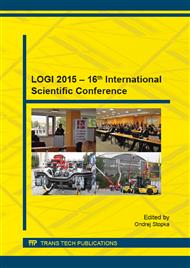[1]
P.L. Abad, Optimal lot size for a perishable good under conditions of finite production and partial backordering and lost sale, In: Computers & Industrial Engineering, Vol. 12 (2000) 457-465.
DOI: 10.1016/s0360-8352(00)00057-7
Google Scholar
[2]
A.W. Anwar, J. Sakovics, A Decentralized Market for a Perishable Good, In: B.E. Journal of Theoretical Economics: Contributions to Theoretical Economics, Vol. 1 (2007) 1-23.
Google Scholar
[3]
B. Deniz, I. Karaesmen, A. Scheller-Wolf, Managing Perishables with Substitution: Inventory Issuance and Replenishment Heuristics, In: Manufacturing & Service Operations Management, Vol. 2 (2010) 319-329.
DOI: 10.1287/msom.1090.0276
Google Scholar
[4]
M. Ferguson, V. Jayaraman, G.C. Souza, Note: An application of the EOQ model with nonlinear holding cost to inventory management of perishables, In: European Journal of Operational Research, Vol. 1 (2007) 485-490.
DOI: 10.1016/j.ejor.2006.04.031
Google Scholar
[5]
D.J. Gougeon, In: Handbook of regression analysis, Vol. 10 (2013) 305.
Google Scholar
[6]
H.I. Hsiao, R.G. M. Kemp, J.G.A.J. Van der Vorst, S.W.F. Omta, A classification of logistic outsourcing levels and their impact on service performance: Evidence from the food processing industry, In: International Journal of Production Economics, Vol. 3 (2010).
DOI: 10.1016/j.ijpe.2009.09.010
Google Scholar
[7]
J. Jaros, V. Melichar, L. Svadlenka, Optimal capital structure as a tool of company competitiveness, In: International multidisciplinary scientific conferences on social sciences and arts, SGEM 2014, Conference proceedings Volume II, 3rd – 9th September 2014, Bulgaria, 2014, pp.527-534.
DOI: 10.5593/sgemsocial2014/b22/s6.067
Google Scholar
[8]
P. Jirsak, M. Mervart, M. Vins, Logistika pro ekonomy, 1st ed., Wolters Kluwer, Praha, Czech Republic, (2012).
Google Scholar
[9]
N. Klabusayova, Support of Logistic Processes in Modern Retail Chain Warehouse, In: Applied Mechanics and Materials, Vol. 3 (2013) 274.
DOI: 10.4028/www.scientific.net/amm.309.274
Google Scholar
[10]
I. Kubasakova, R. Kampf, O. Stopka, Logistics information and communication technology, In: Communications, Vol. 16 (2014) 9-13.
Google Scholar
[11]
H. Liu, H. Tian, Y. Li, An EMD-recursive ARIMA method to predict wind speed for railway strong wind warning system, Journal of Wind Engineering and Industrial Aerodynamics, Vol. 6 (2015) 27-38.
DOI: 10.1016/j.jweia.2015.02.004
Google Scholar
[12]
A.L.S. Maia, F.D.A.T. de Carvalho, Holt's exponential smoothing and neural network models for forecasting interval-valued time series, In: International Journal of Forecasting, Vol. 3 (2011) 740-759.
DOI: 10.1016/j.ijforecast.2010.02.012
Google Scholar
[13]
A.E. Matouk, A.A. Elsadany, E. Ahmed, H.N. Agiza, Dynamical behavior of fractional-order Hastings–Powell food chain model and its discretization, In: Communications in Nonlinear Science and Numerical Simulation, Vol. 10 (2015) 153-167.
DOI: 10.1016/j.cnsns.2015.03.004
Google Scholar
[14]
M. Metghalchi, J. Marcucci, Y. Chang, Are moving average trading rules profitable? Evidence from the European stock markets, In: Applied Economics, Vol. 12 (2015) 1539-1559.
DOI: 10.1080/00036846.2010.543084
Google Scholar
[15]
J. Novotny, P. Duspiva, Factors influencing the purchasing behavior of consumers and their importance for companies, In: Scientific economic magazine E+M, Liberec, Czech Republic, Vol. 1 (2014) 152-166.
Google Scholar
[16]
S. Puntanen, In: Handbook of Regression Analysis, Vol. 2 (2013) 330-331.
Google Scholar
[17]
A. Rosova, Logistics costs of the enterprise, In: Acta Montanistica Slovaca, Vol. 2 (2007) 121-127.
Google Scholar
[18]
W. Stallings, Exponential smoothing, In: Dr. Dobb's Journal, Vol. 3 (1998) 127-130.
Google Scholar
[19]
L.F. Tratar, Joint optimisation of demand forecasting and stock control parameters, In: International Journal of Production Economics, Vol. 1 (2010) 173-179.
DOI: 10.1016/j.ijpe.2010.05.009
Google Scholar
[20]
G.H. Wang, A Study on Logistic and Distribution Innovation of a B2C E-Commerce Company, In: Applied Mechanics and Materials, Vol. 411-414 (2013) 2297.
DOI: 10.4028/www.scientific.net/amm.411-414.2297
Google Scholar
[21]
G. Fedorko, V. Molnar, A. Grincova, M. Dovica, T. Toth, N. Husakova, V. Taraba, M. Kelemen, Failure analysis of irreversible changes in the construction of rubber-textile conveyor belt damage by sherp-edge material impact, In: Engineering Failure Analysis, Vol. 39 (2014).
DOI: 10.1016/j.engfailanal.2014.01.022
Google Scholar
[22]
M. Andrejiova, A. Grincova, D. Marasova, G. Fedorko, V. Molnar, Using logistic regression in tracing the significance of rubber-textile conveyor belt damage, In: Measurement: Journal of the International Measurement Confederation, Vol. 1-2 (2014).
DOI: 10.1016/j.wear.2014.06.026
Google Scholar
[23]
J. Gasparik, V. Zitricky, A new approach to estimating the occupation time of the railway infrastructure, In: Transport, Vol. 4 (2010) 387-393.
Google Scholar
[24]
S. Krile, D. Kezic, Self-Management Principles in Autonomic Service Architecture Supported with Load Balancing Algorithm, In: Automatika, Vol. 2 (2010) 193-204.
DOI: 10.1080/00051144.2010.11828371
Google Scholar
[25]
S. Krile, M. Krile, P. Prusa, Non-Linear Mimimax Problem For Multi-Stop Flight Routes, In: Transport, Vol. 10 (2015) 178-187.
DOI: 10.3846/16484142.2015.1091984
Google Scholar


